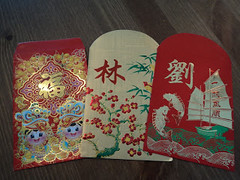
PREV ARTICLE
NEXT ARTICLE
FULL ISSUE
PREV FULL ISSUE
CHINESE LAI-SEE MONEY
What is Lai-see Money? I had to ask after seeing this story from Hong Kong (published January 22, 2014) about two elderly men who collapsed after waiting in a long bank line for " lai see" banknotes.
-Editor
Two elderly men were taken to hospital after fainting as they waited for banks to open to get new notes for their lai see. The two men, both aged more than 80, had been in the queue for an hour when they collapsed, police said. Long queues formed outside branches yesterday as people started to exchange new banknotes for the Lunar New Year. Some banks opened early to help people get new notes. An HSBC branch in Kwun Tong opened 30 minutes earlier than usual to help people, many of them elderly. Workers at the bank distributed tokens beforehand to ease crowding. More staff were also deployed. Apart from new bills, banks also provided well-kept, not-so-new notes for people to exchange. A survey by the Democratic Alliance for the Betterment and Progress of Hong Kong showed that 70 percent prefer giving out HK$20 for lai see. To read the complete article, see: Elderly faint in early lai see banknote queues (www.thestandard.com.hk/news_detail.asp?we_cat=4&art_id=141768&sid=41380754&con_type=1&d_str=20140122&fc=2)
So lai see notes aren't special notes, they're just new notes given as gifts.
But there's another collectible out there associated with lai see - the bank queue tokens! I wonder what they look like?
I found some information on the lai see practice in a 2011 entry on the Just Another Day in Hong Kong blog.
-Editor
But giving Lai See is not as straightforward as it seems and there is a certain etiquette around who you give and how much you give. The general rule of thumb with Lai See is that it’s given from a senior to a junior. For example a boss will give Lai See to his employees, parents to their children and residents to doormen. Married couples will also give Lai See to their single friends. The amount given varies widely depending on who the Lai See is given to. But no matter what the amount, the money should only be given in single notes and should never contain any coins. It’s also important that the notes are new and locals often stand in line at the bank for hours to obtain new fresh notes. To read the complete article, see: Lai See (anotherdayinhongkong.blogspot.com/2011/02/lai-see.html)
While looking for more information I also found this 2006 article by the Hong Kong Monetary Authority encouraging people to use “Good-as-new Banknotes” as a substitute for brand new ones. The demand spikes for brand new notes at New Year, and this consumes resources.
-Editor
The tradition of using brand new banknotes for lai-see uses a lot of resources and is bad for the environment. It is common knowledge that large numbers of brand new banknotes are issued before every Chinese New Year because people like to use them as lai-see money. Last year, the three note-issuing banks in Hong Kong issued an additional 300 million brand new, mostly ten-dollar and twenty-dollar, banknotes with an aggregate face value of more than HK$24 billion. The tradition of using brand new notes to symbolise a new beginning has a long history. But when you receive these brand new lai-see banknotes, do you ever think about the resources and logistics that go into providing them? Three hundred million banknotes weigh 300 metric tonnes, occupy 500 cubic metres of storage space, and could fill 20 twenty-foot containers. The three note-issuing banks need to arrange 500 trips with security escort to transport these brand new banknotes. Last but not the least, it takes 400 metric tonnes of cotton to make the special paper needed to print 300 million banknotes.
To read the complete article, see:
Good-as-new Banknotes Equally Good for Lai-see Money
(economists-pick-research.hktdc.com/business-news/article/Economic-Forum/Good-as-new-Banknotes-Equally-Good-for-Lai-see-Money/ef/en/1/1X000000/1X008OCO.htm)
The Numismatic Bibliomania Society is a non-profit organization promoting numismatic literature. See our web site at coinbooks.org. To submit items for publication in The E-Sylum, write to the Editor at this address: whomren@gmail.com To subscribe go to: https://my.binhost.com/lists/listinfo/esylum All Rights Reserved. NBS Home Page Contact the NBS webmaster 
|
